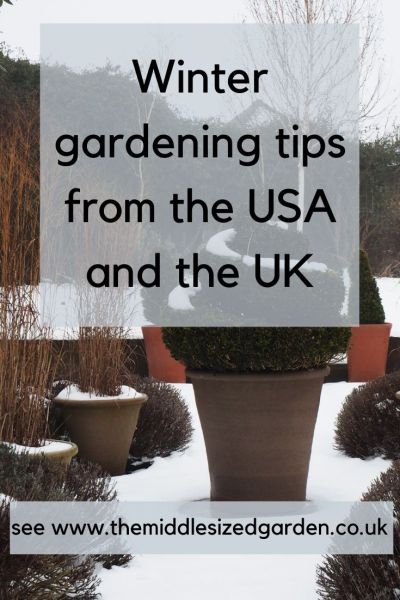Winter gardening – what NOT to do (or what not to worry about…)
I’ve been pulling together winter gardening tips with Erin Schanen who runs the excellent The Impatient Gardener channel on Youtube.
On her channel, we give our top winter gardening ‘to do’ tips, and on the Middlesized Garden YouTube channel we’re talking about what we don’t do – even if traditional advice suggests that we should.
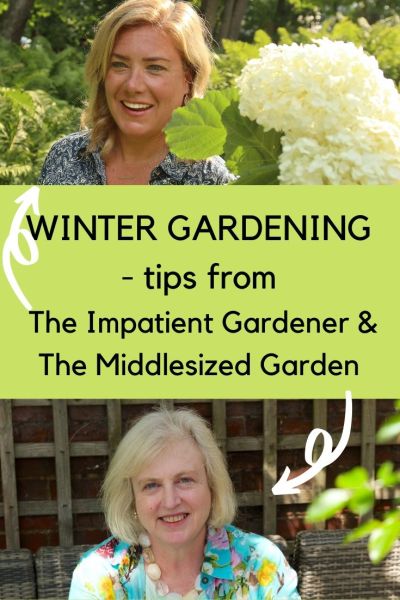
Erin Schanen of the Impatient Gardener YouTube channel and me – sorry that our photographs are both so summery for winter gardening tips!
Why everyone’s winter garden is different
My garden in the South East of England roughly equates to a USDA hardiness zone of 9. Erin’s garden, on the edge of Lake Michigan, is in a USDA Zone 5.
Yet we grow the same plants – lavender, roses, heuchera, hydrangeas, viburnum and more. And we’re both temperate zone gardeners.
We’re at a similar latitude (43 degrees in Wisconsin and 51 degrees in Kent.) However, UK summers are generally cooler than their USDA hardiness zone equivalents.
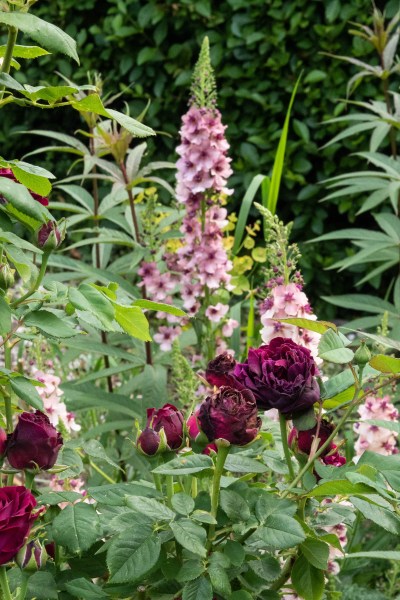
Rose ‘Souvenir du Docteur Jamain’ and Verbascum ‘Copper Rose’ in my garden. The rose can also be grown in Zone 5 in Erin’s garden, The verbascum is only hardy in my garden to Zone 7 so it wouldn’t survive an ‘average’ winter in Erin’s.
But most importantly, I’ve noticed how much a winter can vary even in a small geographic area, as well as from year to year.
Add ‘milder winters’ into the equation. The Met Office says that the decade 2007-2016 had the mildest winters in the UK in three centuries, with an average winter temperature of 4C.
So even if you’re reading winter gardening advice for your area, it may not be the right advice for you. It’s a question of understanding your own garden and adapting what you do, based on what you find works.
USDA hardiness zones
There are several hardiness zone schemes around the world. We have one in the UK, as does Australia and Canada. But the USDA one (United States Department of Agriculture) is probably the most widely used.
It is all about how cold your area gets in winter – on average. This is used for plant buying and growing, because you need the information as to whether the plant will survive the winter in the ground.
There are 13 zones with 0 being the coldest. USDA Zone 12 is tropical – Puerto Rico, for example, is in Zone 12.
Most of coastal Britain (and the coastline of Northern Europe) roughly equates to a Zone 9, although we don’t usually get as hot in summer as inland areas in Zone 9. That means our average winter temperatures are rarely below minus 1- minus 3 Celsius (20-30F). We get relatively few frosts and it doesn’t snow every year.
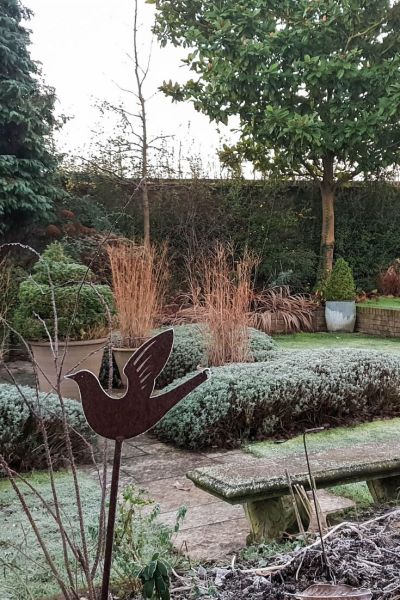
A relatively rare frost outlines a metal bird stake from Cranbrook Iron in my garden.
Inland and on higher ground, however, the UK can go as low as a Zone 6. That means an average winter temperature of minus 23C (minus 10F). Although as Erin says of her Zone 5 (minus 30C average): ‘In some winters we don’t go anywhere near that. Others can be harsher.’
But we’ve all got a micro-climate too
Here in Faversham, we are a mile from the sea. We have regularly topped the ‘hottest place in Britain’ headlines in summer. We get frosts relatively rarely. However, if I drive ten minutes along the coast to Whitstable, it is actually on the sea. Which means frosts are even more rare.
And one winter, I woke to -1C in Faversham. Wanting to photograph Doddington Place Gardens in the frost, I drove there. It is about fifteen minutes drive inland and on a small hill. Which meant that the temperature was -6C. That’s a drop of five degrees within a very short distance.
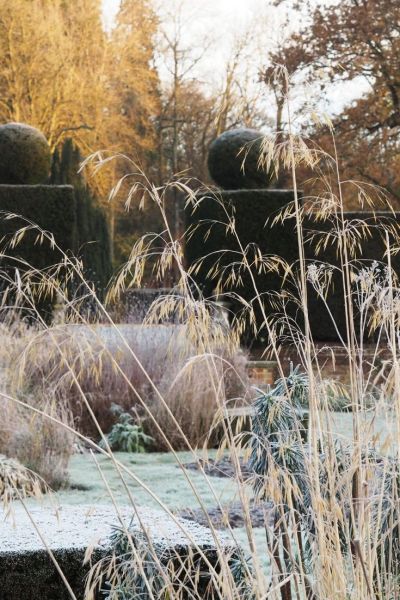
When it’s minus 1C in my garden, it can be minus 6C at Doddington Place Gardens, just fifteen minutes drive away.
So I thought that, between the Impatient Gardener in Zone 5 and the Middlesized Garden in Zone 9, we could offer you a range of winter gardening tips, some of which will be right for your garden. And some of which won’t.
But we are pretty much covering the temperate gardening range, including mild winters for cold zones and cold winters for mild zones.
What I don’t do in Zone 9
I don’t put away the lawn mower. Most of the time, the temperature is above freezing, so the lawn keeps growing. This is a tip I got from professional landscape advisor Matt Jackson of Land & Heritage. When a winter garden looks bare, it looks much better to have a smart lawn. Most professional gardens, in the South East at least, mow throughout the winter.
And I don’t dig over my beds in autumn so that the winter frosts can break up the earth. Apart from the fact that we don’t have very many winter frosts, I practice no-dig (no-till), so I layer manure or compost on the beds in autumn. The worms and micro-organisms dig it in for me.
Finally, I don’t put my container plants up on pot feet. Even though my most valuable plant is in a pot.
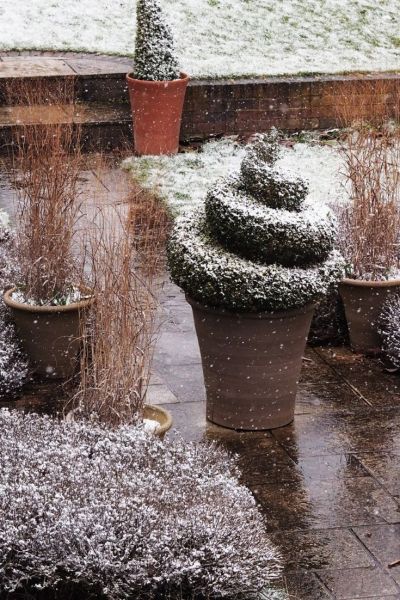
No pot feet. However, we are in a relatively dry part of the UK (rainfall is higher in the winter). Our winters are also relatively mild. Have you had experience of plants in pots dying because of lack of pot feet?
I would add, however, that they don’t have drip trays either. A plant in a pot, sitting in a frozen drip tray, is not going to be a happy plant. It’s probably not even going to be a living plant.
As far as I can see, rain drains adequately from my pots without any need for pot feet. But once again, could that be about my milder winters and shorter, fewer frosts? What has your experience been?
The great debate – can you walk on a frosty lawn?
And I don’t worry about walking across the lawn when it is frosted. I’ve photographed my footsteps on a frosty lawn and can prove that there was no damage to grass when it thawed.
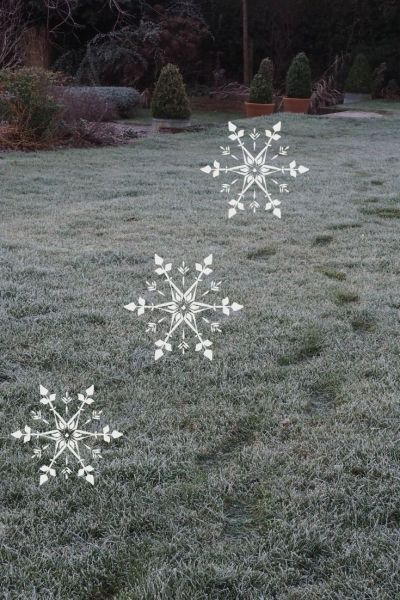
My footsteps on a frosty lawn. I couldn’t see any damage to the lawn later, but our frosts are so rare.
And I had a vigorous debate about this on Twitter, with some professional gardeners saying that they don’t think that people walking on frosty or snowy lawns does discernible harm. But others were adamant that it damages the lawn.
I wonder if – once again – it’s all about your weather, your micro-climate and how often people walk across the lawn. If you rarely get frost or snow, then even if several people walk across your frosty lawn, that is relatively little wear over a whole winter.
But if your lawn is hard with frost, ice or snow for weeks on end and/or has people tramping across it constantly, it stands to reason that the impact will be much greater.
What Erin doesn’t do in Zone 5
Erin’s first warning is an important one for gardeners everywhere. ‘Don’t take advantage of a bout of mild weather to go out in the garden and get ahead,’ she says. ‘If you start pruning and cutting back in a mild spell, then your plants are more likely to be damaged if the cold weather comes back again.’
This is something we British gardeners really experienced with The Beast From the East in March 2017, when a bout of freezing weather arrived on top of a mild spell. Many plants had started budding and gardeners had started pruning. I have never seen so many frost-blistered shrubs and dead leaves on plants. (Here’s a post on how to deal with winter damage to shrubs).
Erin also warns you not to put too much salt on icy paths, decking and terraces. It’s important to make it safe for people to walk on, she says. But if you reapply salt constantly a lot of it can wash into your garden soil and damage plants. She uses grit instead of salt, where appropriate.
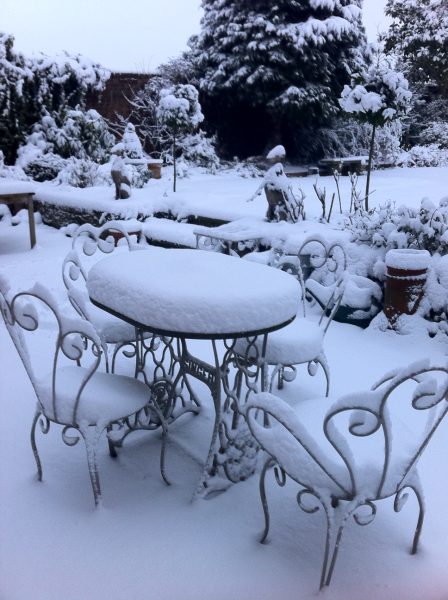
It’s not often we get snow blanketing everything here in the Middlesized Garden. This was winter 2012. Erin advises looking at such scenes, not going out in them.
Snow can blanket a garden completely, so Erin cautions you against walking around your snowy garden. In the video you can see that her borders are so piled high with snow that you wouldn’t be able to tell where the bed ends and the lawn begins. You could tread on the crowns of plants as well as compacting the soil. Ideally, she’d advise against walking on the lawn, too, although she says that’s harder to do.
The ‘must do’ winter gardening tips on video:
And the ‘Don’t do’ winter gardening tips on video:
Check out the Impatient Gardener and Middlesized Garden YouTube channels. The Impatient Gardener is always interesting, with good tips, relevant to temperate climate gardeners wherever we are. And I think that seeing a garden (or a gardening technique) in video can show so much more of it than a photograph does.
Erin’s blog is also called The Impatient Gardener, and it’s a really good read, with lots of advice that would work for any temperate garden.
Shop my favourite gardening books, tools and products
I often get asked for recommendations so I have put together some lists of the products I use on the Middlesized Garden Amazon store. For example, this is a list of my essential garden tools.
Note that links to Amazon are affiliate, which means I get a small fee for qualifying purchases, but that doesn’t affect the price you pay.
Pin to remember:
And do join us on the Middlesized Garden blog on Sunday mornings for tips, ideas and inspiration. See ‘follow by email’ below. And if your experience of winter gardening has been different from mine – or different from winter gardening advice you’ve received, do let me know, either in the comments below or on Twitter.
